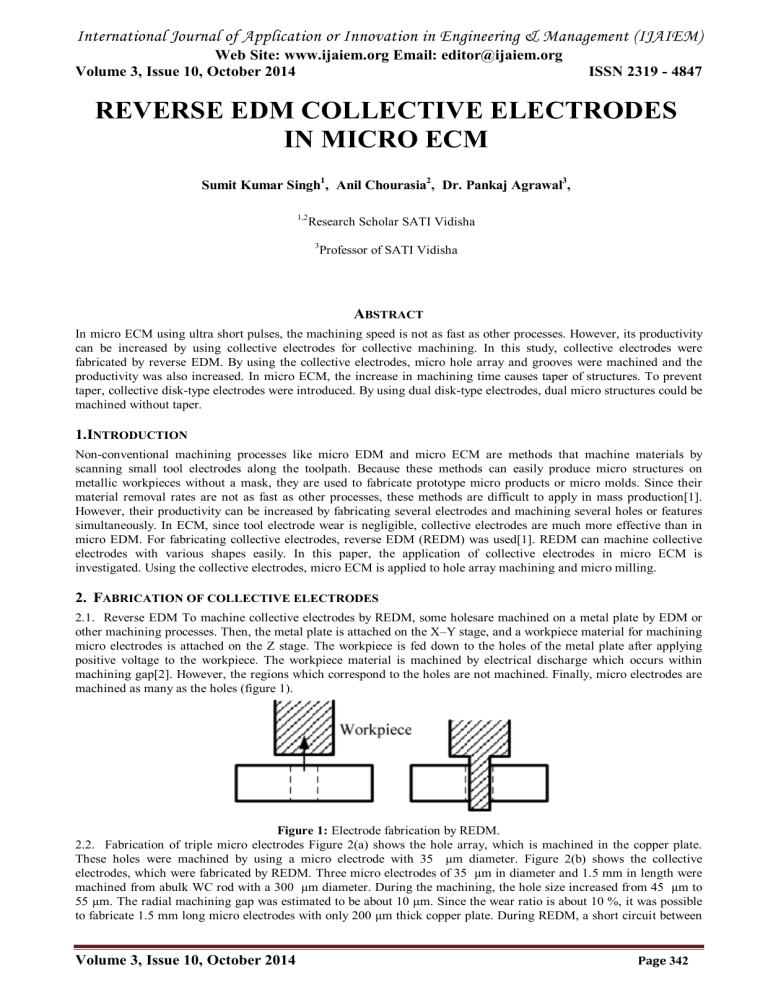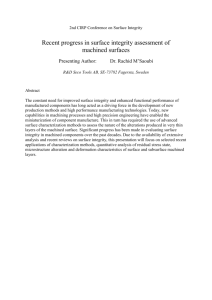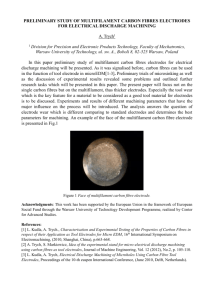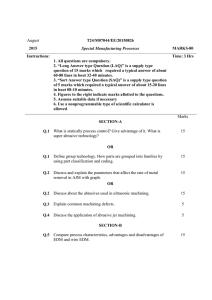REVERSE EDM COLLECTIVE ELECTRODES IN MICRO ECM Web Site: www.ijaiem.org Email:

International Journal of Application or Innovation in Engineering & Management (IJAIEM)
Web Site: www.ijaiem.org Email: editor@ijaiem.org
Volume 3, Issue 10, October 2014 ISSN 2319 - 4847
REVERSE EDM COLLECTIVE ELECTRODES
IN MICRO ECM
Sumit Kumar Singh
1
, Anil Chourasia
2
, Dr. Pankaj Agrawal
3
,
1,2
Research Scholar SATI Vidisha
3
Professor of SATI Vidisha
A
BSTRACT
In micro ECM using ultra short pulses, the machining speed is not as fast as other processes. However, its productivity can be increased by using collective electrodes for collective machining. In this study, collective electrodes were fabricated by reverse EDM. By using the collective electrodes, micro hole array and grooves were machined and the productivity was also increased. In micro ECM, the increase in machining time causes taper of structures. To prevent taper, collective disk-type electrodes were introduced. By using dual disk-type electrodes, dual micro structures could be machined without taper .
1.I
NTRODUCTION
Non-conventional machining processes like micro EDM and micro ECM are methods that machine materials by scanning small tool electrodes along the toolpath. Because these methods can easily produce micro structures on metallic workpieces without a mask, they are used to fabricate prototype micro products or micro molds. Since their material removal rates are not as fast as other processes, these methods are difficult to apply in mass production[1].
However, their productivity can be increased by fabricating several electrodes and machining several holes or features simultaneously. In ECM, since tool electrode wear is negligible, collective electrodes are much more effective than in micro EDM. For fabricating collective electrodes, reverse EDM (REDM) was used[1]. REDM can machine collective electrodes with various shapes easily. In this paper, the application of collective electrodes in micro ECM is investigated. Using the collective electrodes, micro ECM is applied to hole array machining and micro milling.
2.
F
ABRICATION OF COLLECTIVE ELECTRODES
2.1. Reverse EDM To machine collective electrodes by REDM, some holesare machined on a metal plate by EDM or other machining processes. Then, the metal plate is attached on the X–Y stage, and a workpiece material for machining micro electrodes is attached on the Z stage. The workpiece is fed down to the holes of the metal plate after applying positive voltage to the workpiece. The workpiece material is machined by electrical discharge which occurs within machining gap[2]. However, the regions which correspond to the holes are not machined. Finally, micro electrodes are machined as many as the holes (figure 1).
Figure 1: Electrode fabrication by REDM.
2.2. Fabrication of triple micro electrodes Figure 2(a) shows the hole array, which is machined in the copper plate.
These holes were machined by using a micro electrode with 35 µm diameter. Figure 2(b) shows the collective electrodes, which were fabricated by REDM. Three micro electrodes of 35 µm in diameter and 1.5 mm in length were machined from abulk WC rod with a 300 µm diameter. During the machining, the hole size increased from 45 µm to
55 µm. The radial machining gap was estimated to be about 10 µm. Since the wear ratio is about 10 %, it was possible to fabricate 1.5 mm long micro electrodes with only 200 µm thick copper plate. During REDM, a short circuit between
Volume 3, Issue 10, October 2014 Page 342
International Journal of Application or Innovation in Engineering & Management (IJAIEM)
Web Site: www.ijaiem.org Email: editor@ijaiem.org
Volume 3, Issue 10, October 2014 ISSN 2319 - 4847 the electrode and the workpiece occurred, causing a welding. In this experiment, by applying optimal capacitance, 650 pF, the welding could be avoided. At too high or too low capacitances, the welding occurred between the electrode and the workpiece[4]. Since various features can be machined on a plate by micro EDM, several micro electrodes with various shapes can be easily fabricated by REDM.
Figure 2: (a) micro holes for collective electrodes (copper, φ 55 µm), (b) collective electrodes machined by REDM
(WC, φ 35 µm, length 1.5 mm).
3.
C OLLECTIVE MACHINING
3.1. Micro hole array Figure 3 shows the micro hole array, which was machined by micro ECM. By using collective electrodes, three holes were machined simultaneously. A total of 21 holes of 50 µm in diameter were machined on a
100 µm thick stainless steel plate. Pulses with 6.1 V amplitude, and 60 ns pulse on-time were applied in 0.1 M
H2SO4[4]. Since the total surface area was increased in the machining with collective electrodes, the current for each hole was reduced and more machining time is required. The feedrate was 0.1 µm/sec, which is half of the maximum feedrate in the machining with a single electrode. However, since three holes were machined simultaneously, the productivity of collective machining was 50 % higher than that of single machining[5]. More studies about the effect of machining area on machining rate are required.
Figure 3: The micro holes which were machined with triple electrodes (304 SS with 100 µm thickness, hole diameter: about 50 µm, 6.1 V, 60 ns pulse on-time, 1 µs period).
3.2. Machining of collective structures Collective electrodes can be applied not only to the micro hole array machining, but also to 3D micro structure machining. Figure 4 shows micro grooves which were machined by dual electrodes[8].
For betterflushing of electrolyte, material was machined layer-by-layer. For electrochemical milling, 6.0 V pulses of 60 ns duration were applied.
Volume 3, Issue 10, October 2014 Page 343
International Journal of Application or Innovation in Engineering & Management (IJAIEM)
Web Site: www.ijaiem.org Email: editor@ijaiem.org
Volume 3, Issue 10, October 2014 ISSN 2319 - 4847
Figure 4: Dual grooves machined with dual electrodes (304 SS, 50 µm width, 80 µm depth, 6 V, 60 ns pulse on-time, 1
µs period)
As shown in figure 4, the machining gap of initially machined layer is larger than that of lastly machined layer, which causes taper. In ECM, the machining gap increases with the increase in the machining time. Since the machining time for 3D structures is longer than that of micro hole machining, the increase in the machining gap can affect the geometrical accuracy of 3D micro structures more severely. To prevent taper of structures, two different machining conditions were applied in micro hole drilling and disk-type electrode was used [1, 2]. In this paper, for the collective machining without taper, collective disk-type electrodes were machined by reverse EDM. The process for fabrication of collective disk-type electrodes is shown in figure 5. The process of fabrication is similar to that ofcollective electrodes.
However, another hole array of the same size need to be machined. After machining collective electrodes, the electrodes are inserted into the hole array. After inserting electrodes, the electrodes are machined by translating the plate circularly. Then, the parts of electrodes around the plate are machined. By controlling the distance of circular translation, the diameter of electrode neck is determine[9]d. Figure 6 shows dual disk-type electrodes and dual micro columns which were machined with the dual disk-type electrodes. The two columns were machined simultaneously and the taper shape was prevented. The width of columns is about 58 µm and the height is 83 µm.
Figure 5: The machining process for collective disk-type electrodes.
Volume 3, Issue 10, October 2014 Page 344
International Journal of Application or Innovation in Engineering & Management (IJAIEM)
Web Site: www.ijaiem.org Email: editor@ijaiem.org
Volume 3, Issue 10, October 2014 ISSN 2319 - 4847
Figure 6: (a) dual disk-type electrodes (WC, 45 µm disk diameter, 20 µm neck diameter), (b) dual columns machined with dual disk-type electrodes (304 SS, 58 µm width, 83 µm height, 6 V, 60 ns pulse on-time, 1 µs period).
4.
C
ONCLUSION
In micro ECM using ultra short pulses, the machining speed is not as fast as other processes. However, its productivity can be increased by using collective electrodes for collective machining. In this study, collective electrodes were fabricated by reverse[11] EDM. By using the collective electrodes, micro hole array and grooves were machined and the productivity was also increased. In micro ECM, the increase in machining time causes taper of structures. To prevent taper, collective disk-type electrodes were introduced. By using dual disk-type electrodes, dual micro structures could be machined without taper.
R
EFERENCES
[1] Ahn, S. H., Ryu, S. H., Choi, D. K., Chu, C. N., 2004, Electrochemical Micro Drilling Using Ultra Short Pulses,
Prec. Eng., 28/2:129-134.
[2] Kim, B. H., Ryu, S. H., Choi, D. K., Chu, C. N., 2005, Micro Electrochemical Milling, J. Micromech. Microeng.,
15/1:124-129.
[3] D.C. Montgomery. 2009. Design and Analysis of Experiments, 7th Edition, Wiley.
[4] Rajurkar K.P., Levy G., Malshe A., Sundaram M.M., McGeough J., Hu X., Resnick R. and DeSilva A. 2006.
Micro and nano machining by electro-physical and chemical processes. Annals of the CIRP. 55(2): 643-666.
[5] Se Hyun Ahna, Shi Hyoung Ryua, Deok Ki Choi and Chong Nam Chua. 2004. Electro-chemical micro drilling using ultra short pulses. Precision Engineering. 28: 129-134.
[6] Munda J., Malapati M. and Bhattacharyya B. 2005. Experimental study on electrochemical micromachining.
Journal of Materials Processing Technology. 169: 485-492.
[7] Bhattacharyya B., Malapati M., Munda J. and Sarkar A. 2007. Influence of tool vibration on machining performance in electrochemical micro-machining of copper. International Journal of Machine Tools and
Manufacture. 47(2): 335-342.
[8] Bhattacharyya B., Doloi B. and P.S. Sridhar. 2001. Electrochemical micro machining: new possibilities for micro manufacturing. Journal of Material Processing Technology. 113: 301-305.
[9] Bhattacharyya B., Mitra S. and Boro A. K. 2002. Electrochemical Micromachining: New possibilities for micromachining. Robotics and Computer integrated manufacturing. 18: 283-289.
[10] Bhattacharyya B, Muda J. Experimental investigation into electrochemical micromachining (EMM) process.
Journal of Materials Processing Technology2003;140(1–3):287–91.
[11] Shin HS, KimBH, Chu CN. Analysis of the side gap resulting frommicro electro chemical machining with a tungsten wire and ultrashort voltage pulses. Journal of Micromechanics and Microengineering 2008;18(7):1–6.
[12] Brett CMA, Brett AMO. Electrochemistry, principles,methods, and applications. New York: Oxford University
Press; 1993.
[13] International Union of Pure and Applied Chemistry. Compendium of chemical terminology. Blackwell Science;
1997.
[14] W. Natsu, T. Kunimi, and A. Terada Understanding ECM phenomenon using equivalent circuit for electrolyte reaction. Proceeding of the Euspen 9th international conference, p. 491–494.
Volume 3, Issue 10, October 2014 Page 345
International Journal of Application or Innovation in Engineering & Management (IJAIEM)
Web Site: www.ijaiem.org Email: editor@ijaiem.org
Volume 3, Issue 10, October 2014 ISSN 2319 - 4847
[15] Rajurkar KP, Levy G,Malshe A, SundaramMM,McGeough J, Hu X, Resnick R, DeSilva A.Micro and nanomachining by electro-physical and chemical processes.Annuals of the CIRP 2006;55(2):643–66.
[16] Schuster R, Kirchner V, Allongue P, Ertl G. Electrochemical micromachining. Science 2000;289:98–101.
[17] Masuzawa T, Okajima K, Taguchi T, Fujino M. EDM-Lathe for micromachining.CIRP Annals – Manufacturing
Technology 2002;51(1):355–8.
[18] Fan ZW, Hourng LW. The analysis and investigation on the micro pin fabrication by electrochemicalmachining.
International Journal ofMachine Tools and Manufacture 2009;49(7–8):65966.
[19] Choi SH, Ryu SH, Choi DK, Chu CN. Fabrication of WC micro-shaft using electrochemical etching. The
International Journal of Advanced Manufacturing Technology 2007;31(7):682–7.
Volume 3, Issue 10, October 2014 Page 346



